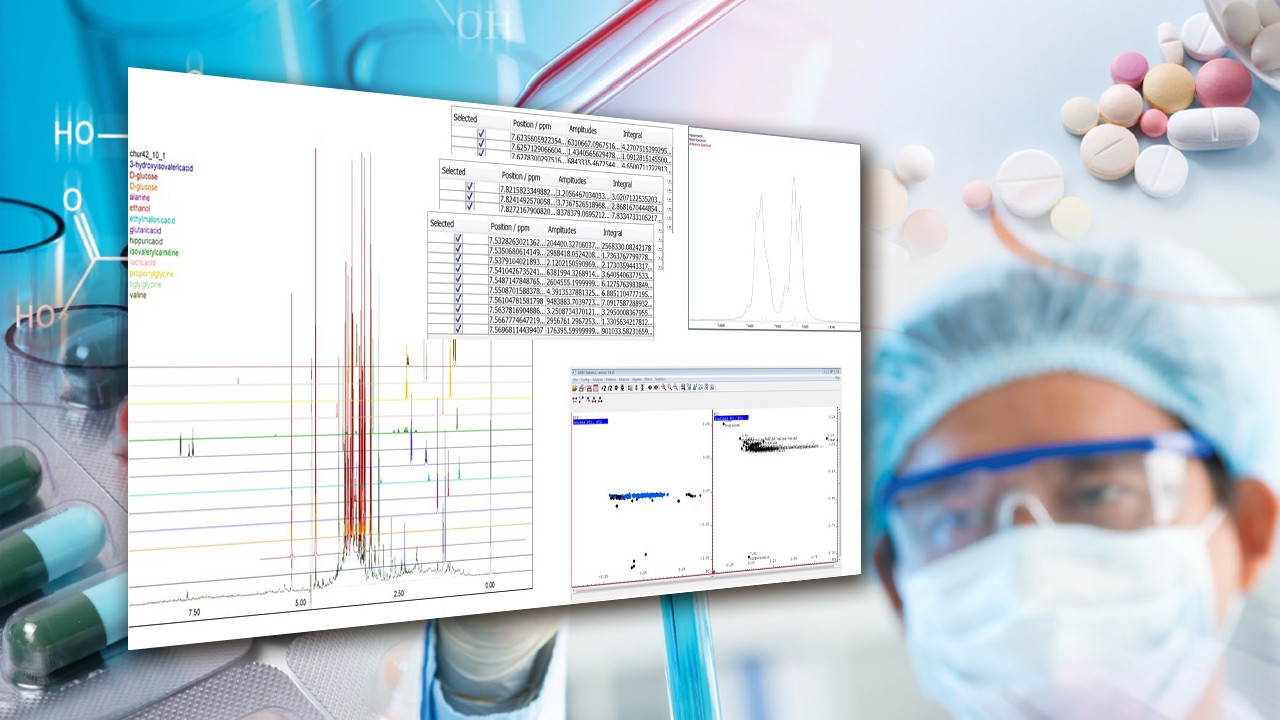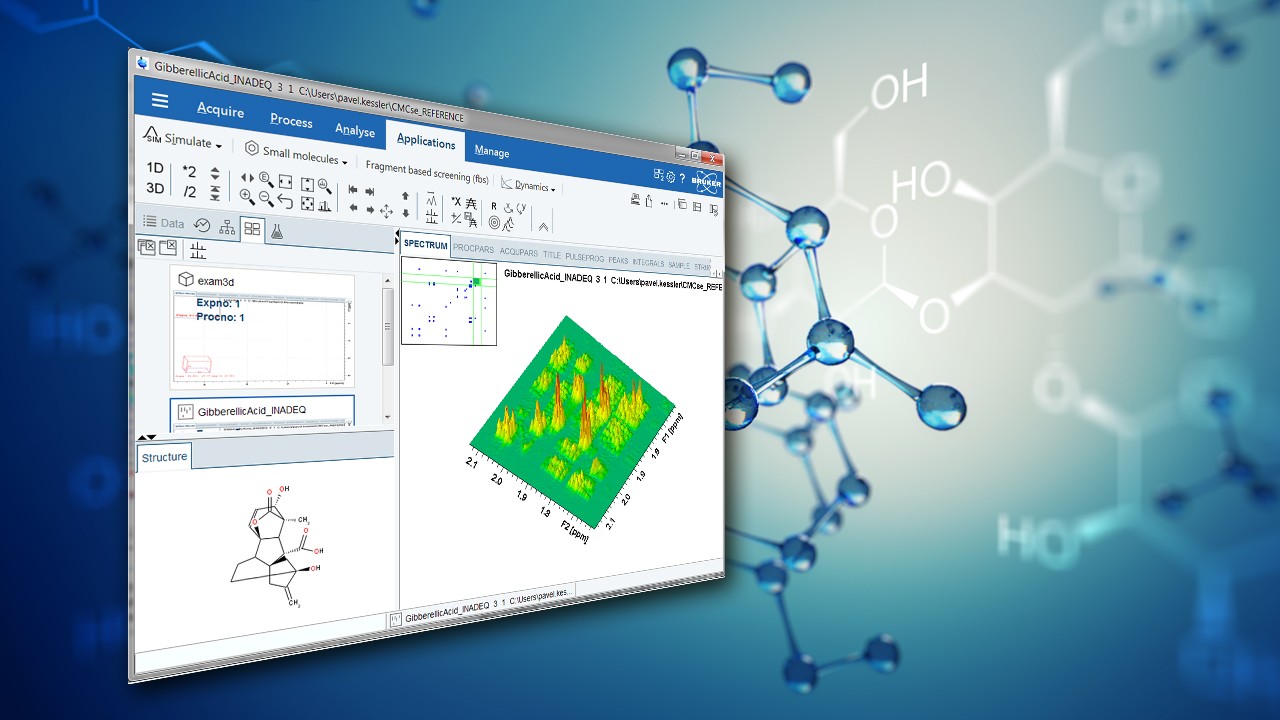

Establishing The Purity of Nutraceuticals and Energy Drinks with NMR
Nutraceuticals and energy drinks are burgeoning billion dollar industries that make use of natural products. To ensure the end product is consistent with labeling and complies with legislation, manufacturers rely on sensitive and specific analytical methods such as nuclear magnetic resonance – NMR spectroscopy – to guarantee freedom from contaminants and safeguard quality.
Introduction
The international herb supplement and remedies market has become a multi-billion dollar industry that is anticipated to reach the $93 billion level by 2015[1], with a corresponding rise in sales of the constituent botanical compounds. The growing use of natural health products, largely driven by the health benefits and cost savings offered in comparison with conventional pharmaceuticals, has given cause for concern, with the possibility that nutraceuticals may be adulterated to enhance efficacy or for economic gain. Such adulteration may also occur inadvertently.
Another booming economy in the United States is the energy drinks market, worth nine billion dollars in 2011. Many energy drinks contain natural product extracts such as ginseng, ginkgo and milk thistle, as well as vitamins, for example niacin and ascorbic acid. As a result, they are classified as dietary supplements and must comply with the 2007 FDA cGMP ruling which requires manufacturers to ensure the identity, purity, strength and composition of their products.
There is a clear need for analytical methods capable of addressing these issues, and NMR-based screening tools have proved very effective. This article describes the application of NMR to the detection of adulteration of the nutraceuticals RegenErect™, Zi Xiu Tang Bee Pollen and borage oil, evaluating product authenticity, and screening of Monster Energy® Drink.
Sample selection
The nutraceuticals and energy drink studied were selected for a variety of reasons. RegenErect, a natural sexual enhancement product stated to contain silkworm, oyster, goji and white willow bark extracts, had been the subject of an FDA recall due to the reported presence of sulfoaildenafil (Figure 1), an unapproved, undeclared analog of sildenafil (Figure 2), the active compound of Viagra®.
An FDA product recall was also issued for Zi Xiu Tang Bee Pollen, which was said to be adulterated with the controlled substance sibutramine (Figure 3), presenting a significant risk for patients with a history of coronary artery disease, congestive heart failure, arrhythmias or stroke.
Borage oil is a major source of ɣ-linolenic acid (GLA), and is used for the prevention and treatment of a number of clinical conditions including osteoporosis, diabetes and cancer. However, cultivation of borage plants is expensive and, as a result, there is a temptation to adulterate the product with the cheaper safflower oil that does not contain GLA. In the case of Monster Energy Drink, a complex mixture of many different compounds must be verified to ensure compliance with the 2007 FDA cGMP regulations for dietary supplements.
NMR analysis
Nutraceuticals
Zi Xiu Tang Bee Pollen and RegenErect were purchased online immediately after the FDA adulteration notices were issued, and borage oil was adulterated with 0.1 to 10 % safflower oil in the laboratory. The Zi Xiu Tang Bee Pollen and RegenErect NMR samples were prepared by dissolving 25 mg of each material in 1 ml of dimethyl sulfoxide-d6 (DMSO-d6) containing 0.5 mM 4,4-dimethyl-4-silapentane-1-sulfonic acid (DSS). The borage oil NMR samples were prepared using chloroform (CDC13).
NMR data was acquired using the workflow-oriented TopSpin™ 3.2 user interface (Bruker) on an AVANCE™ III 400 MHz NMR spectrometer (Bruker) at 298 K. CPMG1d (Carr-Purcell-Meiboom-Gill sequence in 1D mode) and NOESY1d (nuclear Overhauser effect spectroscopy in 1D mode) pulse sequences were performed with 64 scans, 64K points, and a relaxation delay of 4 and 10s respectively. Assure™ – Raw Material Screening (RMS) v1.5 software was used for automated evaluation of the NMR data, enabling identification of sample components through spectral library matching and chemometric analysis. Quantification was performed with Assure-RMS software, using PULCON[2] (pulse length based concentration measurements) to provide a ‘calibrated NMR spectrometer’. The linearity of the NMR spectrometer and the proportionality of the NMR signal to the number of atoms giving rise to the signal allows for the use of calibration to a single quantification standard sample. Freedom from the need to match extinction coefficients or ionization efficiency enables the quantification calibration to be applied to other compounds.
Energy drink
A 400 µl aliquot of a 16 oz. can of Monster Energy Drink was mixed with 200 µl of D2O (deuterium oxide) phosphate buffer and placed in an NMR tube with 1 µl of 300 mM DSS in D2O. NMR spectra of the known constituents of the drink were obtained from the Bruker Biofluid Reference Compound Database or in-house spectral databases.
All NMR experiments were performed using an AVANCE III 600 MHz spectrometer at 298 K with a 5 mm TCI CryoProbe™ (Bruker). 1H NMR spectra were referenced to DSS at 0.00 ppm. Standard 1H NOESY spectra with presaturation were acquired with 32 scans, 64K points and a 20s relaxation delay, at a set temperature of 313 K. The acquisition time was 13 minutes. All spectra were acquired, processed and analyzed automatically, screening samples using Assure-RMS v1.5. Evaluation of the targeted screening method for Monster Energy Drink was carried out using the interactive method builder interface; a spectral database was created using the spectral base builder for the individual compounds in Monster Energy Drink.
Results and discussion
Nutraceuticals
Automated, targeted screening was used to analyze RegenErect, using an NMR spectral database containing sulfoaildenafil to establish the presence or absence of the undeclared drug compound. In addition to the constituents listed in the RegenErect supplement facts – silkworm, white willow bark, goji and oyster extracts – as determined by the FDA in 2011, large quantities of sulfoaildenafil were detected. Quantification was based on the peaks at 8.00, 7.92 and 7.44 ppm (Figure 4, Table 1).
Zi Xiu Tang Bee Pollen was similarly analyzed by targeted NMR screening using Assure-RMS. Six samples from two different lot numbers were analyzed for sibutramine by comparison to a spectral database of potential product constituents. Despite the packaging being marked as ‘GMP’ and ‘Anti-counterfeit’, the NMR spectra clearly show the presence of large quantities of materials that were not declared in the supplement facts (Figure 5).
The targeted NMR screening approach was also applied to the detection of safflower oil adulteration of borage oil, using Assure-RMS with multivariate chemometric tools to quantify the extent of contamination. From figure 7 the NMR spectra of 100 % borage oil and 100 % safflower oil show remarkable similarity, but have specific differences in some of the chemical shift regions, such as 1.7, 2.0 and 2.8ppm. However, in the industry, products sold as borage oil are rarely 100 % safflower oil adulterant; a mixture containing, for example, 10 % adulterant is more common.
Replicate samples (n = 5) of each of the solutions in Table 2 were used to calibrate an Assure-RMS partial least squares (PLS) model, and internal cross-validation of the borage/safflower mixtures (Figure 8) was performed (12 PLS components, R2 = 0.99, root mean square error of cross-validation (RMSECV) = 0.017).
Automated results from two adulterated samples of borage oil (Table 3) show good correlation between the actual and predicted amount of safflower oil present.
Energy drink
Figure 9 shows the 1H NMR spectrum of Monster Energy Drink, with many spectral resonances observed. The specific constituents – sugars, stimulants, organic acids and herbal extract – were identified by an NMR spectral database created using Assure-RMS. Each sample was automatically screened for the compounds in the spectral database, with verification of those substances identified. Figure 10 shows the chemical shift regions of the individual compounds overlaid on the Monster Energy Drink spectrum.
Detailed study of the peak multiplets and lineshape analysis (Figure 11) help to confirm compound identity and enable quantification (Table 4). Ginseng extract was identified, but not quantified, in this study.
Conclusions
NMR is well suited to the evaluation of herbal supplements; as each botanical material has a unique fingerprint, drug adulterants are typically very obvious from the 1H NMR spectrum. Quality control is easily performed using an automated NMR protocol, allowing the identity, purity, strength and composition to be reported. The high reproducibility of NMR enables the use of spectral databases, which is key to the automated identification of adulterants using a targeted NMR screening approach, quantifying components through lineshape analysis or PLS regression.
For complex mixtures such as energy drinks, NMR spectroscopy allows visualization of the individual components with minimal sample preparation, and without the need for separation. An automated NMR-based screening tool such as Assure-RMS could be a powerful approach to the verification of the vast number of dietary supplements found in energy drinks, providing the industry and regulatory authorities with a method for product assessment and quality control.
References
- Source: San Jose, CA-based Global Industry Analysts, Inc.
- Wider, G. and Dreier, L. Measuring Protein Concentrations by NMR Spectroscopy. J Am Chem Soc, 2006. 128(8): p. 2571-2576.
- Jeffery J. et al. Synthesis of sibutramine, a novel cyclobutylalkylamine useful in the treatment of obesity, and its major human metabolites J Chem Soc Perkin Trans 1, 1996. 21: p. 2583-2590.
- Vaysse, J. et al. Analysis of adulterated herbal medicines and dietary supplements marketed for weight loss by DOSY 1H-NMR. Food Addit Contam Part A Chem Anal Control Expo Risk Assess, 2010. 27(7): p. 903-916.


